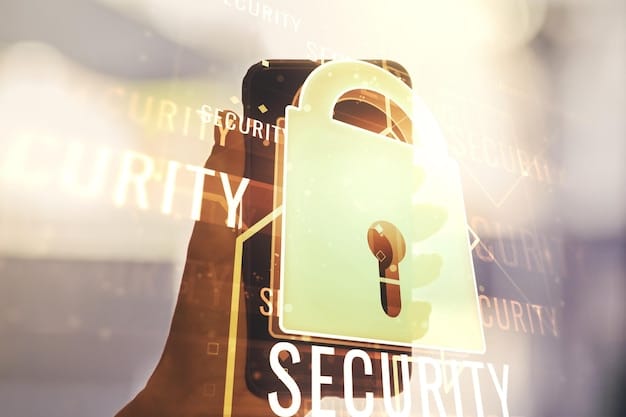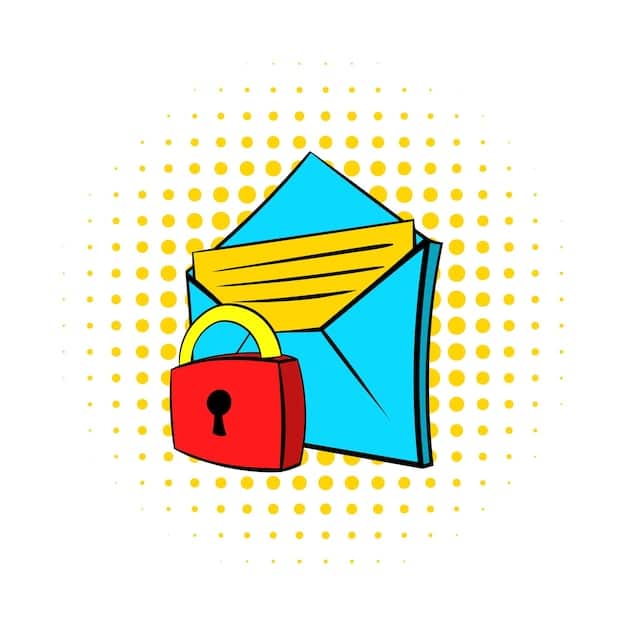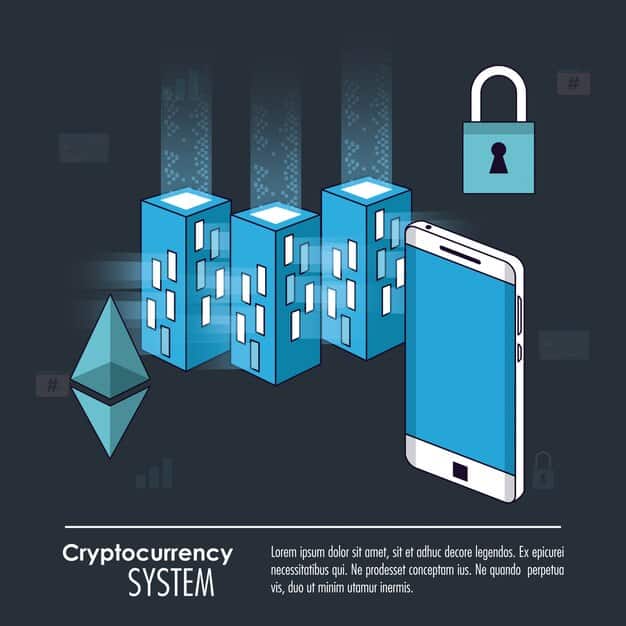Email Privacy: Encryption Guide to Protect Your Messages

Email privacy is achieved through encryption, a process that scrambles email content, rendering it unreadable to unauthorized parties; securing your emails is essential in protecting sensitive information from prying eyes and ensuring confidential communication.
In today’s digital landscape, safeguarding your personal information is paramount, and one of the most vulnerable areas is your email. Protecting your data requires understanding and implementing effective strategies; that’s where email privacy: how to encrypt your messages and keep them safe from prying eyes becomes essential.
Understanding the Importance of Email Privacy
Email has become an indispensable tool for both personal and professional communication. However, its convenience often comes at the cost of privacy. Without proper precautions, your emails can be intercepted and read by third parties. Understanding this risk is the first step toward securing your communications.
Whether you’re discussing confidential business matters, sharing personal information, or simply corresponding with friends and family, maintaining email privacy is crucial. Let’s explore why it matters and what steps you can take to protect your inbox.
The Risks of Unencrypted Email
Unencrypted emails are like postcards; anyone who handles them along the way can read the contents. This makes them vulnerable to various types of attacks and privacy breaches. Here are some of the most significant risks:
- Interception: Hackers and other malicious actors can intercept your emails as they travel across the internet.
- Snooping: Governments and corporations may monitor email communications for various purposes.
- Data breaches: Email accounts are frequent targets in data breaches, potentially exposing your sensitive information.
Legal and Ethical Considerations
Beyond the immediate risks, there are also legal and ethical considerations surrounding email privacy. Many countries have laws protecting electronic communications, and failing to secure your emails could result in legal repercussions. From an ethical standpoint, respecting the privacy of your correspondents is simply good practice.
By understanding the stakes, you can make informed decisions about how to protect your email communications and mitigate potential risks. This is where encryption comes into play, providing a robust shield against prying eyes.

Encryption: The Key to Email Privacy
Encryption is the process of converting readable text (plaintext) into an unreadable format (ciphertext). This ensures that even if your email is intercepted, the contents remain confidential. There are several encryption methods available, each with its own strengths and weaknesses.
Encryption is the cornerstone of email privacy, providing a powerful defense against unauthorized access to your messages. Let’s delve into the different types of encryption and how they work.
End-to-End Encryption (E2EE)
End-to-end encryption (E2EE) is considered the gold standard for email privacy. With E2EE, the email is encrypted on the sender’s device and can only be decrypted by the recipient’s device. This means that even the email provider cannot read the contents of your messages.
E2EE ensures that only the intended recipient can access the information, making it virtually impossible for third parties to intercept and read your emails. Here are some key benefits:
- Total Privacy: Only the sender and recipient can read the messages.
- No Third-Party Access: Even the email provider cannot access the contents.
- Protection Against Data Breaches: If the email provider’s servers are compromised, your encrypted emails remain secure.
Transport Layer Security (TLS)
Transport Layer Security (TLS) is another common encryption method used to secure email communications. TLS encrypts the connection between your email client and the email server, protecting your emails as they travel across the internet.
However, unlike E2EE, TLS does not encrypt the email on your device or the recipient’s device. This means that the email provider can potentially access the contents of your messages. Despite this limitation, TLS is still an essential layer of security.
While TLS is valuable, it’s important to understand its limitations. E2EE offers a more comprehensive solution for those seeking maximum email privacy.

Implementing Email Encryption: Practical Steps
Now that you understand the importance of encryption and the different methods available, let’s explore the practical steps you can take to implement email encryption. This will involve choosing the right tools and configuring your email settings to ensure maximum email privacy.
Follow these steps to secure your email communications effectively.
Choosing an Email Provider with Built-In Encryption
Some email providers offer built-in encryption features, making it easier to secure your emails without requiring additional software. When choosing an email provider, consider factors such as encryption methods, data privacy policies, and user-friendliness.
ProtonMail, Tutanota, and Mailbox.org are examples of email providers that prioritize email privacy and offer end-to-end encryption. These providers ensure that your emails are encrypted by default, offering a seamless and secure experience.
- ProtonMail: Known for its strong encryption and focus on privacy.
- Tutanota: Offers end-to-end encryption and a commitment to open-source software.
- Mailbox.org: Provides a range of privacy-focused features, including encrypted email storage.
Using Encryption Software and Plugins
If your current email provider does not offer built-in encryption, you can use encryption software or plugins to secure your emails. These tools integrate with your email client and allow you to encrypt and decrypt messages easily.
GNU Privacy Guard (GPG) is a popular open-source encryption software that can be used to encrypt emails. Thunderbird, an email client developed by Mozilla, offers built-in support for GPG through Enigmail. Another option is Mailvelope, a browser extension that adds encryption capabilities to webmail services like Gmail and Yahoo Mail.
- GNU Privacy Guard (GPG): A powerful open-source encryption tool.
- Enigmail: A Thunderbird extension that adds GPG support.
- Mailvelope: A browser extension for encrypting webmail.
Best Practices for Maintaining Email Privacy
Implementing email encryption is just one aspect of maintaining email privacy. There are several other best practices you should follow to protect your sensitive information and ensure secure communications.
By adopting these practices, you can minimize the risk of email interception and data breaches.
Strong Passwords and Two-Factor Authentication
Using strong, unique passwords for your email accounts is essential. A strong password should be at least 12 characters long and include a combination of uppercase and lowercase letters, numbers, and symbols. It is also crucial to enable two-factor authentication (2FA) for your email accounts.
2FA adds an extra layer of security by requiring a second verification factor, such as a code sent to your phone, in addition to your password. This makes it much harder for hackers to access your email accounts, even if they manage to obtain your password.
Maintaining strong passwords and enabling 2FA are fundamental steps in protecting your email privacy.
Avoiding Phishing and Suspicious Links
Phishing is a type of cyberattack where attackers attempt to trick you into revealing sensitive information, such as your email password or credit card details. Phishing emails often look like legitimate messages from trusted organizations, such as banks or email providers.
Be wary of emails that ask you to click on links or provide personal information. Always verify the sender’s identity before clicking on any links or downloading attachments. If you suspect an email is a phishing attempt, report it to your email provider and delete it.
Staying vigilant and cautious is critical for preventing phishing attacks and protecting your email privacy.
Regularly Updating Software and Devices
Keeping your software and devices updated is crucial for maintaining email privacy. Software updates often include security patches that fix vulnerabilities and protect against new threats. Make sure to update your operating system, email client, and security software regularly.
By keeping your software up to date, you minimize the risk of falling victim to known exploits and vulnerabilities.
Advanced Email Privacy Techniques
Beyond the basics of encryption and best practices, there are more advanced techniques you can use to enhance your email privacy. These techniques offer additional layers of security and anonymity, making it even harder for third parties to monitor your communications.
Let’s explore some of these advanced techniques.
Using Virtual Private Networks (VPNs)
A Virtual Private Network (VPN) encrypts your internet traffic and routes it through a server in a location of your choice. This makes it harder for ISPs and other third parties to monitor your online activity, including your email communications.
When using a VPN, your IP address is hidden, and your internet traffic is encrypted, providing an added layer of email privacy. Choose a reputable VPN provider with a no-logs policy to ensure that your data remains confidential.
VPNs are a valuable tool for protecting your online privacy, including your email communications.
Email Aliases and Forwarding
Using email aliases and forwarding can help protect your primary email address and reduce the risk of spam and phishing attacks. An email alias is a temporary or disposable email address that forwards messages to your primary email address.
When signing up for online services or newsletters, use an email alias instead of your primary email address. This prevents your primary email address from being exposed to potential spammers and phishers. If an alias starts receiving spam, you can simply delete it without affecting your primary email address.
Email aliases and forwarding provide an additional layer of protection for your email privacy.
Future Trends in Email Privacy
As technology evolves, so too will the methods and techniques used to protect email privacy. Staying informed about emerging trends and developments in the field is crucial for maintaining secure communications.
Let’s take a look at some of the future trends in email privacy.
Decentralized Email Systems
Decentralized email systems aim to eliminate the need for centralized email providers, such as Google and Microsoft. These systems use blockchain technology and peer-to-peer networks to distribute email communications, making it harder for governments and corporations to monitor your emails.
Decentralized email systems are still in their early stages of development, but they hold great promise for enhancing email privacy and security.
Artificial Intelligence (AI) in Email Security
Artificial Intelligence (AI) is playing an increasingly important role in email privacy and security. AI-powered tools can detect and block phishing emails, identify malicious attachments, and analyze email content for potential privacy breaches.
As AI technology advances, it will become an even more valuable tool for protecting your email communications.
| Key Point | Brief Description |
|---|---|
| 🔑 Encryption | Secures email content, making it unreadable to unauthorized users. |
| 🛡️ Strong Passwords | Utilize strong, unique passwords and enable two-factor authentication. |
| ⚠️ Phishing Awareness | Be cautious of suspicious emails and avoid clicking on unfamiliar links. |
| 🌐 VPN Usage | Enhance privacy by encrypting internet traffic and hiding your IP address. |
Frequently Asked Questions
▼
Email encryption is the process of converting readable email content into an unreadable format to protect it from unauthorized access. It is crucial because it ensures that even if intercepted, the contents remain confidential, safeguarding sensitive information.
▼
E2EE encrypts emails on the sender’s device and decrypts them only on the recipient’s device. This ensures that only the intended recipient can read the message, making it virtually impossible for third parties, including email providers, to access the contents.
▼
Yes, you can encrypt emails on services like Gmail or Yahoo Mail using browser extensions such as Mailvelope. These extensions integrate with your webmail service and allow you to encrypt and decrypt messages using encryption protocols like GPG.
▼
Best practices include using strong, unique passwords, enabling two-factor authentication, avoiding phishing emails and suspicious links, regularly updating software and devices, and considering VPNs for added security.
▼
VPNs encrypt your internet traffic and route it through a server in a location of your choice, making it harder for ISPs and other third parties to monitor your online activity, including email communications.
Conclusion
Securing your email communications is essential in today’s digital age. By understanding the risks, implementing encryption methods, and following best practices, you can protect your sensitive information and maintain email privacy. Stay informed about emerging trends and technologies to ensure your communications remain secure in the future.





